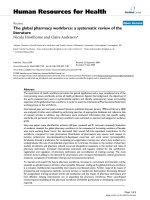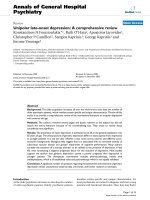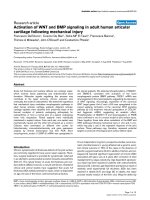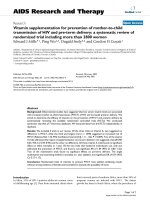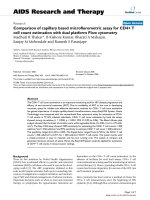Báo cáo y học: "Cost-effectiveness of injury prevention a systematic review of municipality based interventions" potx
Bạn đang xem bản rút gọn của tài liệu. Xem và tải ngay bản đầy đủ của tài liệu tại đây (266.02 KB, 7 trang )
REVIEW Open Access
Cost-effectiveness of injury prevention -
a systematic review of municipality based
interventions
Harald Gyllensvärd
Abstract
Background: Injuries are a major cause of mortality and morbidity which together result in avoidable societal
costs. Due to limited resources, injury prevention interventions need to demonstrate cost-effectiveness to justify
their implementation. However, the existing knowledge in this area is limited. Consequently, a systematic review is
needed to support decision-making and to assist in the targeting of future research. The aim of this review is to
critically appraise the published economic evidence of injury prevention interventions at the municipal level.
Methods: A search strategy was developed to focus a literature search in PubMed, Embase, Cochrane and NHS
EED. Studi es were eligible for inclusion if they were economic evaluations of injury prevention interventions that
could be implemented by municipalities; had a relevant comparison group; did not include any form of
medication or drug use; and were assessed as having at least an acceptable quality from an economic point of
view. Articles were screened in three steps. In the final step, studies were critically appraised using a check-list
based on Drummond’s check-list for assessing economic evaluations.
Results: Of 791 potential articles 20 were accepted for inclusion. Seven studies showed net savings; four showed a
cost per health score gained; six showed both savings and a cost per health score gained but for different time
horizons and populations; and three showed no effect. The interventions targeted a range of areas such as traffic
safety, fire safety, hip fractures, and spor t injuries. One studied a multi-targeted community-based program. Only six
articles used effectiveness data generated within the study.
Conclusions: The results indicate that there are injury prevention interventions that offer good use of societal
resources. However, there is a lack of economic evidence surrounding injury prevention interventions. This lack of
evidence needs to be met by further research about the economic aspects of injury prevention interven tions to
improve the information available for decision-making.
Background
Injuries are a major cause of morbidity and mortality and
result in great costs to society. Annually more than five
million people worldwide are killed due to injuries, which
account for 9% of global mortality. Even more people are
temp orary or p ermanent disabled [1]. It is also estimated
that injuries account for 14% of global life years lost
when using the measure Years of Life Lost [2]. Injury
prevention interventions could mitigate the impact of
injuries on health, and at the moment a research project
is running to explore what the success factors are for
municipality based injury preventative and safety promo-
tion work [3]. Here, a municipality is defined as a n
administrative entity for local governance in a defined
territory. As a part of the mentioned research project the
importance of achieving cost-effectiveness is recognized.
This is important because it is insuff icient for interven-
tions to demonstrate effectiveness only to justify imple-
mentation due to limited resources. This calls into
question whether injury prevention interventions can be
seen as cost-effective or not; that is, whether or not they
can be seen as good use of societal resources.
Systematic reviews of the cost-effectiveness of different
interventions provide excellent overviews of the current
Correspondence:
Department of Medical and Health Sciences, Linköping University, SE-581 83
Linköping, Sweden
Gyllensvärd Cost Effectiveness and Resource Allocation 2010, 8:17
/>© 2010 Gyllensvärd; licensee BioMed Central Ltd. Thi s is an Open Access article dist ributed under the terms of the Creative Commons
Attribution License ( which permits unrestricted use, distribution, and reproduction in
any medium, provided the original work is properly cited.
state of knowledge about various topics. They can facili-
tate decision-making by providing compiled and criti-
cally appraised evidence on the cost-effectiveness of
different interventions. This is especially warranted in a
world where costs are inc reasing and budgets become
more financially constrained. In the end of the day deci-
sion-makers need to make and justify decisions on how
to allocate societal resources so that maximum health
outcome is obtained for a confined budget.
Previously, some reviews targeting the cost-effective-
ness of different in jury prevention interven tions have
been conducted. For instance, Smith and Fordham [4]
reviewed the cost-effectiveness of “interventions in redu-
cing the risk of new falls, or modifying the harm caused
in the event of a fall, for the general unselected popula-
tion of the elderly living independently in the commu-
nity”. Also, Miller and Levy [5] reviewed cost-outcome
analyses in injury prevention and control, and made
estimates from the literature found. However, there is a
paucity of economic evidence concerning prevention in
general [6] and in injury prevention as w ell. Hence, it is
important to compile the existing evidence and reveal
important gaps for future research to target.
This systematic review of published literature was
conducted to elucidate what optio ns are available for a
decision-maker, at the municipal level, se arching eco-
nomic eviden ce on injury pre vention interventions.
Therefo re, the objective of this review study was to sys-
tematically i dentify, critically appraise, and compile eco-
nomic evaluations of injury prevention interventions
that could be conducted by municipalities.
Methods
Search strategy
A search strategy was developed in collaboration with a
librarian. The strategy comprised four different parts: (a)
injuries or accidents, (b) prevention, (c) economic evalua-
tion, and (d) demarcation. MeSH terms such as accident
prevention, wounds and injuries, prevention and control,
primary prevention, protective devices, and cost-benefit
analysis were used in different combinations in all data-
bases except i n Embase; in Embase similar terms were
identified and used by utilising the thesaurus.
Searches were conducted in PubMed, Embase,
Cochrane, and NHS EED and they were limited to the
last ten years, from 1998 until the beginning of August
2008. Additional searches were also conducted to
include the not yet MeSH indexed articles. The searches
used the MeSH terms’ entry terms and were limited to
2008 or the last 180 days. The search strategies used are
available - see additional file 1 and 2.
Inclusion criteria
For inclusion, the study should
• be an economic evaluation of an injury prevention
intervention (cost-effectiveness, cost-benefit, or cost-
utility analysis);
• include some sort of comparison (randomised con-
trolled trial, quasi-experimental, longitudinal cohort,
or case-control); a judgement was made if the com-
parison groups were comparable;
• evaluate an intervention that could be conducted
by municipalities; and
• be published in English.
In addition, there is a need for a clarification of which
interventions that might be included or excluded on the
basis of the “could be conducted by municipalities” cri-
terion, because municipalities are organized differently
across the world. Accordingly, interventions including
legislative reforms, interventions targeting workers, and
interventions including modifications of vehicles have
been excluded in this review. On the other hand, inter-
ventions targeting nursing home residents have been
included. Furthermore, interventions do not need to
have been undertaken by municipalities to be included;
municipalities should, however, have the possibility to
implement the intervention at hand.
Exclusion criteria
A study was excluded if
• the intervention included any form of medication
or drug use;
• it was assessed as not being relevant to the general
context; and
• it had a n unacceptable quality, appraised by using
a checklist previously used by The Swedish Council
on Technology Assessment in Health Care [7].
Review articles were excluded, although they were
later revised to see if they would add any valuable
information.
Sifting process
Sifting was systematically conducted in three different
steps and w as carried out by one assessor. In the first
sift titles and abstracts were screened; in the second sift
papers were obtained and screened if they met the
inclusion and exclusion criteria; in the third sift papers
were critically appraised by using a checklist [7]. Only
papers with at least an acceptable quality were included.
Gyllensvärd Cost Effectiveness and Resource Allocation 2010, 8:17
/>Page 2 of 7
Quality assessment
In the last sift, articles were critically appraised using a
modified checklist for evaluating health economic stu-
dies [7]. The checklist is in turn based on Drummond’ s
checklist [8]. The assessment of an arti cle’s quality can-
not be given with mathematical precision, therefore The
Swedish Council on Technology Assessment in Health
Care propose thre e categories to express the quality of a
study: High, acceptable, or not acceptable quality, which
corresponds to more than 80, 50-80 or less than 50 per-
cent positive answers, respectively, of the applicable
checklist questions [7]. If an ar ticle had previously been
reviewed, and was available on the Centre for Reviews
and Dissemination’s database, that review was used to
validate the quality assessment. When there were ambi-
guities, a revision was conducted.
Data extraction
Findings from the included studies were extracted into
pre-developed evidence tables. To facil itate comparisons
all cost estimates were converted to US dollars in price
year 2007 by first using GDP deflators and then Pur-
chasing Power Parities (PPPs) as suggested by the
Campbell & Cochrane Economics Methods Group [9].
Apt data were retrieved from IMF and OECD [10,11]. If
the p rice year was not reported in the article, the year
before public ation was used when converting cost data.
Critical appraisals of the quality of the included studies
were also conducted. Furthermore, the interpretation
and validity was briefly discussed. In the case of ambigu-
ities a more detailed perusal was carried out.
Meta-analysis
Due to the research question and to the heterogeneity in
economic evaluation methodologies it is neither feasible
nor meaningful to conduct a meta-analysis [12].
Results
Result of the sifting process
The systematic literature search y ielded 791 potentially
relevant papers. Following a sifting process in three
steps shown in Figure 1, 20 articles were finally included
in the systematic review. Most articles were discarded
due to vio lating the inclusion or exclusion criteria,
although many duplicates were also excluded. In the
final sift t hree articles, which did not meet the qua lity
criterion, were excluded.
Interventions by area, economic result, setting, and
population
The included articles comprise different kinds of injury
prevention interventions shown in Table 1 by area and
by economic result. The table clearly shows that there
are few articles in each area except in fall reduction and
the use of hip protectors. Furthermore, many studies
report a potential of being cost saving and only three
studies report no effects.
Studies were also conducted across different settings,
compromising eight studies from North America, eight
from Europe, and four from Australia and New Zeeland
as well as different populations, with the main focus on
older people with 15 interventions solely targeting them.
Methodological characteristics and synthesis of the
included studies
The extracted data from the included studies are deli-
neated and juxtaposed in a table enclosed in A dditional
file 3. First out are six articles that base their findings
on effectiveness data generated within the study, fol-
lowed by 14 articles using effectiveness data reported
elsewhere. The quality and validity of t he included
Potentially relevant papers
(n = 791)
PubMed (247), Embase
(246), NHS EED (104) and
Coc
hr
a
n
e
(
1
9
4
)
Papers retrieved for
more detailed evaluation
(n = 72)
Sift 1: 719 papers did
not meet inclusion
criteria or were
duplicates
Sift 2: 49 papers did
not meet inclusion
criteria
Potentially appropriate
papers to be included in
the review (n = 23)
Sift 3: 3 papers did not
meet quality criteria
Papers included in the
review
(
n = 20
)
Figure 1 Flow chart showing sifting process.
Gyllensvärd Cost Effectiveness and Resource Allocation 2010, 8:17
/>Page 3 of 7
studies are appraised and briefly discussed qualitatively
in the column furthest to the right in the table. In gen-
eral, there are great methodological varieties between
studies which make comparisons more difficult.
The limited number of studies in each area makes
evidence difficult to synthesise in specific areas. How-
ever, nine s tudies examined the use of hip p rotectors
[13-21]. Many reported cost saving results although one
randomised controlled trial reported no significant
effects [21].
Six studies tar geted fall reduction in elderly people.
One randomised controlled trial of a multidisciplinary
program reported no effect [22]. Four studies calculated
a cost per prevented fall and the sixth study reported a
QALY (Quality Adjusted Life Year) gain and a minor
saving [23-27].
Two studies examined smoke alarm give-awa y inter-
ventions in high risk areas [28,29]. One reported net-
savings and one no eff ects. All other studies investigated
interventions not directly comparable and are, hence,
only reported in Table 1 and in Additional file 3.
Discussion
Principal findings
This systematic review identified few economic evalua-
tion studies of injury prevention interventions, of accep-
table quality, that might be conducted at the municipal
level. Hence, it is shown that there is a paucity of eco-
nomic evidence - especially in low- and middle-income
countries - in this field. Consequently, the evidence
based options, including economic information, available
for a decision-maker at the municipal level are limited.
However, the review reveals that many i nterventions
included in the review are reported to be effective and
also cost saving. This shows a potential for societies to
obtain good value for societal resources spent.
In general, it seems like interventions targeted at high-
risk individuals are more cost-effective. Probably, this is
the c ase if the cost of identification of high-risk indivi-
duals does not reduce cost-effectiveness. Furthermore,
the results indicate great disparities in methodologies
used, which make co mparisons more difficult. The out-
comes of many interventions are also context depen-
dent. Hence, the results and their transferability s hould
be interpreted with caution.
Interpretation of the included studies
Before interpreting the studies some caveats should be
noted. Different interventions cannot directly be com-
pared because there might be, for instance, contextual,
compositional, or metho dologi cal differences. Especially,
in economic evaluations, with disparities in methods,
there are difficulties to synthesise evidence into a coher-
ent whole [30]. Consequently, caution should be exer-
cised when int erpreting, synthesizing, and generalising
results.
Some interpretations could however be made on the
basis of the included studies. Many interventions
including the use of hip protectors were reported as
cost saving. However, the only study that did not
import effectiveness data f rom other sources reported
no significant effects [21]. This may be due to the low
compliance reported and that the study was underpow-
ered. Nevertheless, it is likely that compliance is a key
factor for achieving effectiveness; and that cost-effec-
tiveness will be enhanced if compliance could be
improved. Moreover, some of the studies suggest that
interventions targ eting older groups are more cost-
effective than interventi ons targeting younger groups.
Some of the studies also suggest that women profit
from the use of hip protectors at an earlier age than
men do.
Table 1 Papers reviewed by area and result. Numbers in parentheses show articles with effectiveness data generated
within the study
Area Number of papers
n=20
Showing net savings Showing a cost per health score gained Showing no effects
Community-based, multitargeted 1 1
Traffic safety 1 1
a
1
a
Smoke alarm 2 1(1) 1
Fall reduction 6 2
b
4(3)
b
1
Hip Protectors 9 7
c
4
c
1(1)
Sports 1 1(1)
d
1(1)
d
Total 20 14 10 3
a
One study reported both net savings (time horiz on 8 years) and a cost per health score gained (time horizon 1 year) and is thus reported twice [31].
b
One study reported both net savings (time horizon 10 years) and a cost per health score gained (time hori zon 1 year) and is thus reported twice [27].
c
Included are three articles that report both net savings and a cost per health score gained and are thus reported twice each. One study show net savings
without nursing aide time added and a cost per health score gained if added [17]. Another study show net savings for an older population [15]. The third study
show net savings for a high-risk population [14].
d
One study reported both net savings (time horizon “long term”) and a cost per health score gained (time horizon 36 weeks) and is thus reported twice [33].
Gyllensvärd Cost Effectiveness and Resource Allocation 2010, 8:17
/>Page 4 of 7
Among fall prevention interventions in elderly, most
were reported as being effective. In four interventions
the cost-effectiveness was reported as a cost per fall pre-
vented. If we do not know the value of a prevented fall
this information is of limi ted value for decision-makers.
One study reported that the investigated p rogram was
very likely to be cost-effective and encourage similar
programs [24]. On the other hand, another study found
no significant effects of the progra m, and thus did not
recommend it [22]. There are also contextual and com-
positional differences between interventions, which
influence outcome and make comparisons and synthesis
difficult. However, Salkeld et al. concludes that their
programislikelytobemorecost-effectiveamongolder
people with a history of falls [26]. Hence, it may be the
case that interventions targeted at high risk individuals
could give more value for money than interventions tar-
geted at medium and low risk individuals.
The evidence seems conflicting in smoke alarm give-
away interventions in high risk areas. It seems that
many smoke alarms stopped functioning [28,29]. Func-
tioning smoke alarms is likely to be a crucial part of
successful smoke alarm interventions, and if the life
time of smoke alarms could be enhanced this might
improve the outcome of similar programs. All remaining
studies are too heterogeneous to synthesis, and are thus
reported solely in the table in Additional file 3
[21,31-33].
To conclude, analysing all the interventions, it seems
that many interventions are targeted tow ards high-risk
individuals and that some interventions show better
cost-effectiveness for high-risk groups. It is plausible
that interventions targeted towards high-risk individuals
have a potential to be more cost-effective than interven-
tions targeted to the general population as long as iden-
tifying high-risk individuals is relatively inexpensive.
Strengths and weaknesses of this review
First, the review is systematic, including a comprehen-
sive search strategy in several major databases. Hence,
most of the relevant published studies should have been
captured. Second, the quality and validity of the
included studies are reviewed, which simplify the inter-
pretations and conclusions of the studies. Third, the
review provides a better decisio n basis by including eco-
nomic evidence, when deciding about implementing
injury prevention interventions. Fourth, the review
guides future research by giving an overvie w of the
existing economic evidence in injury prevention.
This study is not without limitations. First, only peer-
reviewed literature in English has been considered.
Accordingly ther e may be a risk of publication bias; that
is, there is a risk o f that n egative findings might not
have reached publication to the same extend as positive
findings [34]. Possibly important non peer-revie wed
literature could also have b een omitted. Second, even
though the assessor used established checklists in the
sifting and quality assess ment processes there are always
elements of subjectivity. Also, using only one assessor
enhances the risk of error. To minimise these risks a
validation of the quality appra isal was conducted with
the help from abstracts, written by health economists, in
the da tabases of Centre for Reviews and Dissemination
and Euronheed, when available; 15 out of 20 articles
were found in these databases and the unanimity was
high between the appraisals. Third, this review only
included identified st udies with an economic perspective
- see Anderson [12] for a discussion about the limita-
tions. This fac t disregards evidence including only effec-
tiveness data. To obtain better knowledge, it would have
been desirable to conduct comprehensive systematic
reviews on the health related effectiveness, besides col-
lecting information about the costs, of each intervention
of interest. That would however be more resource
demanding. Fourth, econo mic models, which are
included in this review, often rely on assumptions and
data collected from various sources. This makes the
results more prone to uncertaint y and therefore th e
results should be interpreted with caution. Finally, the
interventions included in the review do not give a fair
picture of the populations and settings where the bur-
den of injury is the greate st; thus the results are biased
in the following ways: 1. The interventions are limited
to high-income countries although 90% of injuries occur
in low- and middle-income countries [35]. 2. Falls
account for only 8% of all injuries, yet most of the
included interventions relate to falls [35]. 3. The review
is mainly focused on elderly even though almost 50% of
the world’s injury-relate d mortality occurs in people
aged between 15-44 years [36]. 4. Suicide, homicide,
drowning, and poisoning are causes that account for
approximately 29% of all injury deaths [35]; despite this,
no interventions targeting these cause s have me t the
inclusion criteria.
Comparison with previous reviews
To the a uthor’s knowledge this is the first systematic
review with a health economic perspective in this area.
Other reviews, with economic perspectives, have studied
more specific topics. For instance, Smith and Fordham
have reviewed the cost-effectiveness of “interventions in
reducing the risk of new falls, or modifying the harm
caused in the event of a fall” among elderly. One of
their conclusions is that there are very few economic
studies relating to fall prevention programs [4]. The
scarcity of economi c studies is in line with the conclu-
sions in this study. Miller and Levy have made estimates
from literat ure reviewed conc erning cost-outco me
Gyllensvärd Cost Effectiveness and Resource Allocation 2010, 8:17
/>Page 5 of 7
analyses in injury prevention and control [5]. From 84
estimates made in the United States they conclude that
injury prevention interventions often can reduce medical
costs and save lives. This is also in line with the findings
in this study.
Conclusions
The findings of this s ystematic review can be concluded
in three main points: injury prevention interventions
can reduce injuries and costs at the same time, there is
a paucity of evidence, and there is a need for more stan-
dardised research.
First, the findings of this systematic review suggest
that some injury prevention interventions seem to offer
good use of societ al resources, and some that do not.
This information of specific programs is valuable and
useful to de cision-maker s deciding about their imple-
mentation. However, it is important to note that contex-
tual factors often play a pivotal role for the outcome of
interventions. Co nsequently the results from individual
studies should be seen as indicative rather than precise
when transferring them to other settings. Furthermore,
it is vital to recognize that politi cal and other noneco-
nomic factors also influence decisions. Hence, economic
evidence should be an important part in decision-mak-
ing but there are other important parts as well.
Second, t he review reveals a deficiency of economic
evidence surrounding injury prevention interventions -
especially in low- and middle-income countries - at the
municipal level. T his calls for further research. Further
research should be targeted at areas where there is a
lack of knowledge - as this review reveals - and where
increased knowledge could be beneficial. See, for
instance, Jonsson for a guide in selecting topics to assess
used by The Swedish Council on Technology Assess-
ment in Health Care SBU [37]. One possible way to go
forward is also to construct economic models and popu-
late them with the best available evidence. That is a
relatively cheap way to o btain valuable information for
decision-makers and one example of that is the article:
Modeling the cost effectiven ess of inj ury interventions
in lower and middle income countries: opportunities
and challenges by Bishai and Hyder [38].
Third, it is important that future economic evaluations
use similar methodologies to simplify comparisons. For
instance, if perspectives other then the societal are
requested, then the societal perspective should also be
included in the analysis. Increased knowledge and stan-
dardisation of evaluations facilitates decision-making;
part ly by increasing the options available for a decision-
maker asking for economic evidence and partly by facili-
tating comparisons.
Further more, it would be valuable to explore the ma r-
ginal effects (that is, dose-response relationships) of
different injury prevention interventions to find the opti-
mallevel.Togetthisknowledgeweneeda“more
detailed understanding of how different combinations
and levels o f resources, and their associated opportu nity
costs, cause different patterns of outcomes” in different
populations and contexts [12]. Hence, it is important for
future research to target these issues.
Additional material
Additional file 1: Search strategy overview. The file shows an
overview over the search strategies employed, for the different
databases.
Additional file 2: Search strategies.
Additional file 3: Description of the included articles. Studies with
imported effectiveness data and model studies are presented last.
Acknowledgements
This study has benefited from useful comments by different people.
Especially, I would like to thank Håkan Brodin, Koustuv Dalal, Lars Lindholm,
and Kent Lindqvist for valuable suggestions and comments at various times
during the process of conducting the study and on earlier drafts of this
paper. I am also grateful for valuable comments by two anonymous
reviewers. Finally, I want to thank Sara Rondahl for help in designing the
search strategy. The Swedish Contingencies Agency is gratefully
acknowledged for financial support.
Competing interests
The author declares that they have no competing interests.
Received: 5 October 2009 Accepted: 10 September 2010
Published: 10 September 2010
References
1. Injuries. [ />2. World Health Organisation: World Health Statistics 2009 Geneva 2009.
3. Kommunbaserat säkerhetsfrämjande arbete [Municipality based safety
promotion work]. [ />d=9952&a=118045].
4. Smith RD, Fordham RJ: Economics of fall prevention programs: Evidence
and research priorities. Expert Rev Pharmacoecon Outcomes Res 2001,
1:59-67.
5. Miller TR, Levy DT: Cost-outcome analysis in injury prevention and
control: eighty-four recent estimates for the United States. Med Care
2000, 38:562-582.
6. Schwappach DL, Boluarte TA, Suhrcke M: The economics of primary
prevention of cardiovascular disease - a systematic review of economic
evaluations. Cost Eff Resour Alloc 2007, 5:5.
7. The Swedish Council on Technology Assessment in Health Care (SBU): Open
Angle Glaucoma. Diagnosis, Follow-up and Treatment Stockholm 2008.
8. Drummond MF, Sculpher M, Torrance G, O´Brien B, Stoddart G: Methods for
the economic evaluation of health care programmes New York: Oxford
University Press, 3 2005.
9. Shemilt I, Mugford M, Byford S, Drummond M, Eisenstein E, Knapp M,
Mallender J, McDaid D, Vale L, Walker D: Chapter 15: Incorporating
economics evidence. In Cochrane Handbook for Systematic Reviews of
Interventions. Version 5.0.2 [updated September 2009]. Edited by: Higgins J,
Green S. The Cochrane Collaboration; 2009:.
10. World Economic Outlook Database. [ />weo/2009/01/weodata/index.aspx].
11. Purchasing Power Parities Data. [ />datasetcode=SNA_TABLE4].
12. Anderson R: Systematic reviews of economic evaluations: utility or
futility? Health Econ 2009, 19:350-364.
Gyllensvärd Cost Effectiveness and Resource Allocation 2010, 8:17
/>Page 6 of 7
13. Colon-Emeric CS, Datta SK, Matchar DB: An economic analysis of external
hip protector use in ambulatory nursing facility residents. Age and
Ageing 2003, 32:47-52.
14. Fleurence RL: Cost-effectiveness of fracture prevention treatments in the
elderly. Int J Technol Assess Health Care 2004, 20:184-191.
15. Honkanen LA, Mushlin AI, Lachs M, Schackman BR: Can hip protector use
cost-effectively prevent fractures in community-dwelling geriatric
populations? J Am Geriatr Soc 2006, 54:1658-1665.
16. Meyer G, Wegscheider K, Kersten JF, Icks A, Muhlhauser I: Increased use of
hip protectors in nursing homes: economic analysis of a cluster
randomized, controlled trial. J Am Geriatr Soc 2005, 53:2153-2158.
17. Sawka AM, Gafni A, Boulos P, Beattie K, Papaioannou A, Cranney A,
Hanley DA, Adachi JD, Cheung A, Papadimitropoulos EA, Thabane L: Could
a policy of provision of hip protectors to elderly nursing home residents
result in cost savings in acute hip fracture care? The case of Ontario,
Canada. Osteoporos Int 2007, 18:819-827.
18. Segui-Gomez M, Keuffel E, Frick K: Cost and effectiveness of hip
protectors among the elderly. Int J Technol Assess Health Care 2002,
18:55-66.
19. Singh S, Sun HY, Anis AH: Cost-effectiveness of hip protectors in the
prevention of osteoporosis related hip fractures in elderly nursing home
residents. Journal of Rheumatology 2004, 31:1607-1613.
20. Waldegger L, Cranney A, Man-Son-Hing M, Coyle D: Cost-effectiveness of
hip protectors in institutional dwelling elderly. Osteoporos Int 2003,
14:243-250.
21. van Schoor NM, de Bruyne MC, van der Roer N, Lommerse E, van
Tulder MW, Bouter LM, Lips P: Cost-effectiveness of hip protectors in frail
institutionalized elderly. Osteoporos Int 2004, 15:964-969.
22. Hendriks MRC, Evers SMAA, Bleijlevens MHC, Van Haastregt JCM,
Crebolder HFJM, Van Eijk JTM: Cost-effectiveness of a multidisciplinary fall
prevention program in community-dwelling elderly people: A
randomized controlled trial (ISRCTN 64716113). Int J Technol Assess Health
Care 2008, 24:193-202.
23. Campbell AJ, Robertson MC, La Grow SJ, Kerse NM, Sanderson GF,
Jacobs RJ, Sharp DM, Hale LA: Randomised controlled trial of prevention
of falls in people aged >/= 75 with severe visual impairment: the VIP
trial. Bmj 2005, 331:817.
24. Johansson P, Sadigh S, Tillgren P, Rehnberg C: Non-pharmaceutical
prevention of hip fractures - A cost-effectiveness analysis of a
community-based elderly safety promotion program in Sweden. Cost Eff
Resour Alloc 2008, 6:11.
25. Robertson MC, Devlin N, Scuffham P, Gardner MM, Buchner DM,
Campbell AJ: Economic evaluation of a community based exercise
programme to prevent falls. J Epidemiol Community Health 2001,
55:600-606.
26. Salkeld G, Cumming RG, O
’Neill E, Thomas M, Szonyi G, Westbury C: The
cost effectiveness of a home hazard reduction program to reduce falls
among older persons. Aust N Z J Public Health 2000, 24:265-271.
27. Smith RD, Widiatmoko D: The cost-effectiveness of home assessment and
modification to reduce falls in the elderly. Aust N Z J Public Health 1998,
22:436-440.
28. Ginnelly L, Sculpher M, Bojke C, Roberts I, Wade A, Diguseppi C:
Determining the cost effectiveness of a smoke alarm give-away
program using data from a randomized controlled trial. Eur J Public
Health 2005, 15:448-453.
29. Haddix AC, Mallonee S, Waxweiler R, Douglas MR: Cost effectiveness
analysis of a smoke alarm giveaway program in Oklahoma City,
Oklahoma. Injury Prevention 2001, 7:276-281.
30. Centre for Reviews and Dissemination: Systematic Reviews. CRD’s guidance
for undertaking reviews in health care York, 3 2009.
31. Goldstein JA, Winston FK, Kallan MJ, Branas CC, Schwartz JS: Medicaid-
Based Child Restraint System Disbursement and Education and the
Vaccines for Children Program: Comparative Cost-effectiveness.
Ambulatory Pediatrics 2008, 8:58-65.
32. Lindqvist K, Lindholm L: A cost-benefit analysis of the community-based
injury prevention programme in Motala, Sweden–a WHO Safe
Community. Public Health 2001, 115:317-322.
33. Verhagen EALM, Van Tulder M, Van Der Beek AJ, Bouter LM, Van
Mechelen W: An economic evaluation of a proprioceptive balance board
training programme for the prevention of ankle sprains in volleyball. Br
J Sports Med 2005, 39:111-115.
34. Polit DF, Beck CT: Nursing research: generating and assessing evidence for
nursing practice Philadelphia: Wolters Kluwer Health/Lippincott Williams &
Wilkins 2008.
35. World Health Organisation: Injuries and Violence: The Facts Geneva 2010.
36. World Health Organisation: The injury chart book: a graphical overview of the
global burden of injuries Geneva 2002.
37. Jonsson E: History of health technology assessment in Sweden. Int J
Technol Assess Health Care 2009, 25(Suppl 1):42-52.
38. Bishai DM, Hyder AA: Modeling the cost effectiveness of injury
interventions in lower and middle income countries: opportunities and
challenges. Cost Eff Resour Alloc 2006, 4:2.
doi:10.1186/1478-7547-8-17
Cite this article as: Gyllensvärd: Cost-effectiveness of injury prevention -
a systematic review of municipality based interventions. Cost
Effectiveness and Resource Allocation 2010 8:17.
Submit your next manuscript to BioMed Central
and take full advantage of:
• Convenient online submission
• Thorough peer review
• No space constraints or color figure charges
• Immediate publication on acceptance
• Inclusion in PubMed, CAS, Scopus and Google Scholar
• Research which is freely available for redistribution
Submit your manuscript at
www.biomedcentral.com/submit
Gyllensvärd Cost Effectiveness and Resource Allocation 2010, 8:17
/>Page 7 of 7
